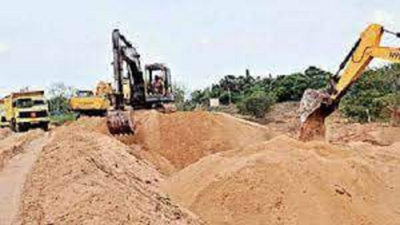- News
- City News
- nagpur News
- In Maharashtra, 19 mining bids called, 50% in forests
Trending
This story is from February 16, 2023
In Maharashtra, 19 mining bids called, 50% in forests
In a significant move, the directorate of geology and mining (DGM), Maharashtra, has invited bids for granting leases for 19 mines in the state on nearly 10,200 hectare. At least 50% mines will be on forested land, mostly in Gadchiroli and Chandrapur districts, where man-animal conflict is at its peak.

Representative Image
NAGPUR: In a significant move, the directorate of geology and mining (DGM), Maharashtra, has invited bids for granting leases for 19 mines in the state on nearly 10,200 hectare. At least 50% mines will be on forested land, mostly in Gadchiroli and Chandrapur districts, where man-animal conflict is at its peak.
On February 3, 2023, the DGM floated tenders inviting bids from parties for grant of mining leases for bauxite, limestone, iron ore, manganese, copper, base metal, platinum, nickel-chromium, gold etc.For some mines, like the controversial Surjagadh mine, composite licenses will be issued. The last date to submit tenders is March 14.

Of the 19 mineral blocks, five (3 limestones, 1 each bauxite and copper) include granting mining lease, while 14 blocks (3 for gold-chromium-nickel, 2 bauxite, 1 each for base metal, copper, nickel-chromium, and 6 iron ore) are for issuing composite licenses. Of these mines, 11 are in Vidarbha and 8 are in Western Maharashtra.
Composite license means prospecting license-cum-mining lease, which is a two-stage concession granted under rules for the purpose of undertaking prospecting operations followed by mining operations in a seamless manner.
The fresh bids for mining leases and composite licenses will spell doom for tigers and wildlife in Gadchiroli and Chandrapur districts, where 104 people have lost their lives in 2022. It may also stir up trouble in Surjagarh, where many tribals are opposed to mining and a further extension to mining firms.
Apart from existing iron mining by Llyods Metals in 348 hectare, the fears of tribals have come true with bids being invited for six blocks, whose area comes to nearly 47sq km (4,700 hectare), 2.5 times the area of the entire Gorewada Zoo and Rescue Centre (19.14sqkm) at Nagpur.
Some sensitive mines like Minzari, Bamhani in Sindewahi, Bhisi in Chimur in the Tadoba landscape, and Savli in Parsheoni threaten to destroy tiger habitats. "It is clear that there is an urgent need to reform the current processes for activities which involve forest land diversions," says wildlife biologist Aditya Joshi.
"The inclusion of mines like Bamhani in Tadoba buffer shows that there is a clear lack of involvement of various stakeholders before the conceptualization of these projects. Such haphazard proposals in sensitive ecological areas act against the government's commitment to act in the light of climate change, and to preserve India's forests and wildlife," adds Joshi.
"The forests of eastern Maharashtra, which are known for their rich wildlife and visited by thousands of tourists world over to sight tigers are under attack from large-scale mining operations," said Uday Patel, former honorary warden.
TOI highlighted the associated impact of these mines on tiger corridors and habitats. However, no action has been initiated by authorities.
On February 3, 2023, the DGM floated tenders inviting bids from parties for grant of mining leases for bauxite, limestone, iron ore, manganese, copper, base metal, platinum, nickel-chromium, gold etc.For some mines, like the controversial Surjagadh mine, composite licenses will be issued. The last date to submit tenders is March 14.

Of the 19 mineral blocks, five (3 limestones, 1 each bauxite and copper) include granting mining lease, while 14 blocks (3 for gold-chromium-nickel, 2 bauxite, 1 each for base metal, copper, nickel-chromium, and 6 iron ore) are for issuing composite licenses. Of these mines, 11 are in Vidarbha and 8 are in Western Maharashtra.
Earlier, bids for seven sensitive mines were invited on September 16, 2022. However, the DGM on November 14, 2022, annulled the auction without specifying reasons. Now, again bids have been invited for these mines. The DGM officials failed to reveal how much revenue the state will generate from these 19 bids.
Composite license means prospecting license-cum-mining lease, which is a two-stage concession granted under rules for the purpose of undertaking prospecting operations followed by mining operations in a seamless manner.
The fresh bids for mining leases and composite licenses will spell doom for tigers and wildlife in Gadchiroli and Chandrapur districts, where 104 people have lost their lives in 2022. It may also stir up trouble in Surjagarh, where many tribals are opposed to mining and a further extension to mining firms.
Apart from existing iron mining by Llyods Metals in 348 hectare, the fears of tribals have come true with bids being invited for six blocks, whose area comes to nearly 47sq km (4,700 hectare), 2.5 times the area of the entire Gorewada Zoo and Rescue Centre (19.14sqkm) at Nagpur.
Some sensitive mines like Minzari, Bamhani in Sindewahi, Bhisi in Chimur in the Tadoba landscape, and Savli in Parsheoni threaten to destroy tiger habitats. "It is clear that there is an urgent need to reform the current processes for activities which involve forest land diversions," says wildlife biologist Aditya Joshi.
"The inclusion of mines like Bamhani in Tadoba buffer shows that there is a clear lack of involvement of various stakeholders before the conceptualization of these projects. Such haphazard proposals in sensitive ecological areas act against the government's commitment to act in the light of climate change, and to preserve India's forests and wildlife," adds Joshi.
"The forests of eastern Maharashtra, which are known for their rich wildlife and visited by thousands of tourists world over to sight tigers are under attack from large-scale mining operations," said Uday Patel, former honorary warden.
TOI highlighted the associated impact of these mines on tiger corridors and habitats. However, no action has been initiated by authorities.
End of Article
FOLLOW US ON SOCIAL MEDIA










